Attention: この記事は数年前に書かれたものであり、AP®プログラムの最新の変更を反映していない可能性があります。 私たちは徐々にこれらの記事を更新しており、この記事が更新された時点でこの免責事項を削除します。 お待たせしました。
減数分裂という言葉は、ギリシャ語に由来します。 これは、細胞内の染色体の数が少なくなることを意味します。 減数分裂は、真核細胞(植物、動物、菌類)の染色体が減少するプロセスで、有性生殖に必要な生殖細胞(配偶子/性細胞)が作られるようになる。 減数分裂では、2組の染色体(2倍体)が1組の染色体(倍数体)に還元され、生殖細胞や胞子が作られる。 これが有性生殖で結合すると、できあがった接合子は2倍体となる。
なぜか
結局は染色体数なのです。 もしn=46の染色体、あるいはn=23の染色体を2対持つヒトが、染色体を減らさずに生殖すると、卵細胞と精子細胞はともにn=46の染色体を持つことになります。 これが融合して配偶子となると、接合体(胚)はn=92の染色体を持つことになり、必要な数の2倍になってしまうのです。 この場合、子供の遺伝子に異常が生じることになります。 さらに、この子供がn=92の染色体を持つ別の子供と繁殖すると、その子供は184の染色体を持つことになります。 この数は増え続けることになります。
減数分裂が始まる前に、細胞の核にある染色体は複製されます。 これは、減数分裂によって、親細胞の半分の染色体を持つ4つの娘細胞、つまり1つの二倍体細胞から4つのハプロイド細胞が作られるからです。 つまり、1個の2倍体細胞から4個の倍数体細胞ができるのです。倍数体細胞は1組の染色体(n)を含み、2倍体細胞は2組の染色体(2n)を含みます。 親細胞を4n(4倍体)細胞にしてから分裂を開始しなければなりません。 つまり、n = 46 の染色体を持つ細胞は、n = 92 の染色体を持つ細胞に変換され、減数分裂の後、n = 23 の染色体を持つ 4 つの細胞が作られます。
減数分裂は有糸分裂とほぼ同じ方法で始まります。
減数分裂は有糸分裂と同じように始まり、染色体の複製後、すべての染色体は姉妹染色体(染色体の同じ半分の部分)に分離します。 しかし、ここで類似点が終わります。 減数分裂では、さらに組換えや交差というプロセスが発生します。 組換えでは、一対の染色体が並んで組み合わされ、それぞれの染色体が他の染色体の一部を持つようになります。
このように、減数分裂は組換えを利用して、2倍体の親細胞や互いに同一ではない、4つのハプロイドの娘細胞を作り出します。 これらは、第一減数分裂の前段階I、第一メタフェース、第一アナフェース、第一テロフェース、そして第二減数分裂の前段階II、第二メタフェース、第二アナフェース、第二テロフェースです。
- 二価染色体 – 一対の相同染色体がキアズマによって結合されたもの
- キアズマ – 染色体が遺伝物質を交換するときに交差する点。
- 動原体 – 染色体の狭窄点
- 二本鎖 – 四本鎖の半分、相同染色体のシナプス対の半分
- 相同染色体 – 元の染色体とその複製でできた染色体の対です。
- メタフェース板 – 細胞の正中線
- モナド – 分離後、四分子集合の各染色体はモナドを形成する。
- 核膜 – 核を包む二重膜。
- 核小体 – 核内でrRNAを生成する中心部。
- 姉妹染色体 – 染色体を形成する2つの同一の染色体。
- スピンドル線維 – 細胞の1極から別の極まで走る微小管の束で、染色体はこれに沿って動きます。
- シナプス/シナプシス – 2つの相同染色体が物理的に接触するプロセス
- 四分子 – キアズマによって一緒に保持されている相同染色体のペア
減数第一分裂
ここにあるのは第一分裂の全体像(図1)ですが、各段階について詳しく見ていきます。 各段階の意義とその理由を理解できるはずです。

Image Source.Image(英語)
減数分裂の全貌(図1)。 Wikimedia Commons
図1:減数第一分裂の4段階と前段階をさらに4つの小段階に分ける
1.前段階(prophase)。 染色体の凝縮、相同染色体のシナプス、そしてシナプス染色体間の遺伝物質の交差です。

Image Source.Image.Source.Image.Source.Image.Image.Image.Image.Image.Image.Image.Image.Image.Image.II。 Wikimedia Commons
図2:減数第一分裂前期の各段階
レプトネマ
レプトテン期とも呼ばれ、クロマチンが凝縮して可視染色体ができることが特徴である。 相同性検索が始まります。
ザイゴネマ
この段階は、ザイゴテン期とも呼ばれます。 相同性検索が続き、相同染色体が大まかにペアリングして二価の染色体を形成する。
パキネマ
パキテン期とも呼ばれ、相同な二価の染色体の間でシナプテンマール複合体がさらに発達し、シナプスを形成する段階である。 この段階では、各二価に2対の姉妹染色分体が存在することが明らかである。 一方の対の姉妹染色分体は、他方の対の姉妹染色分体に対して非姉妹染色分体である。 この4つの染色体を合わせて4分子と呼ぶ。
二倍体
この段階は二倍体段階とも呼ばれる。 姉妹染色体のペアが分離し始める。
二核性
染色体はさらに分離しますが、姉妹染色体のキアズマ(単数形キアズマ)を介して結合したままです。 分離が進むと、キアスマタが染色体の末端に向かって移動する。 核膜と核小体が劣化し、各染色体の動原体が紡錘体繊維に付着し、メタフェース板上に整列する。
2.メタフェースI
この段階は、有糸分裂のメタフェースと似ています。 The spindle fibers attached to the centromere of each tetrad align the chromosomes so that one half of each tetrad is oriented towards each pole.
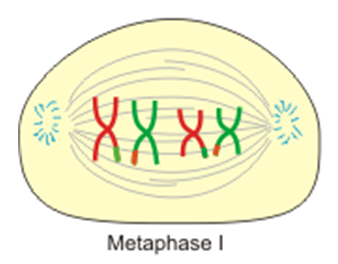
Image Source: Wikimedia Commons
Figure 3: The alignment of tetrads during metaphase I of meiosis I
3. Anaphase I
At anaphase I, the chromosomes do not split into their sister chromatids, but each tetrad is split into its chromosome pairs (dyads). These are pulled to opposite poles in a process known as disjunction. Anaphase ends with the same number of dyads at each pole as the haploid number of the parent cell.
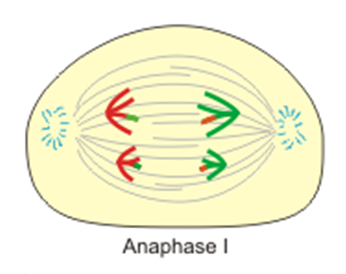
Image Source: Wikimedia Commons
Figure 4: The splitting of chromosome dyads during anaphase I
4. Telophase I
In some organisms, telophase I is entered and a nuclear membrane forms around the dyads at each pole, before a short interphase period is reached. In other organisms, telophase I is skipped, and meiosis II is entered.

Image Source: Wikimedia Commons
Figure 5: Formation of nuclear membrane isolating the two dyads
Meiosis II
Once again, we will explore the second meiosis phase much like the first one. Here is a full picture of meiosis II following telophase I:
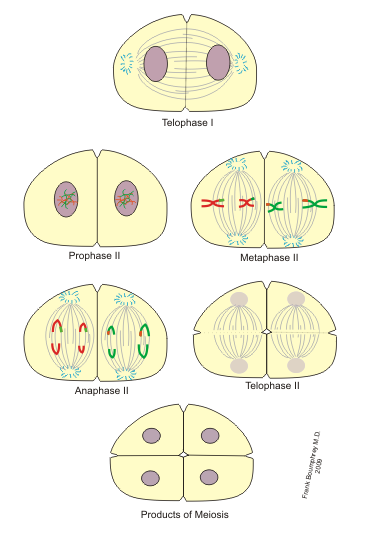
Image Source: Wikimedia Commons
Figure 6: The four stages of meiosis II, with four haploid cells at the end of this phase
1. Prophase II
Sister chromatids form dyads connected by a centromere. These are situated at the center of the cell. No condensation of chromatic material or dissolving of nuclear membranes need occur.
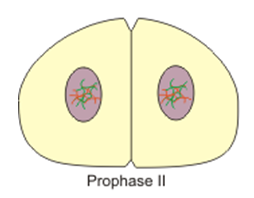
Image Source: Wikimedia Commons
Figure 7: The sister chromatids from the dyads are attached by a centromere during prophase II
2. Metaphase II
Spindle fibers attached to the centromere of each sister chromatid align the dyads at the metaphase plate, with one half of the dyad facing toward each pole.
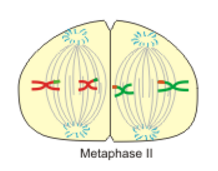
Image Source: Wikimedia Commons
Figure 8: The metaphase plate forms separating each half of the dyad
3. Anaphase II
The spindle fibers attached to each sister chromatid shorten, and each is pulled to an opposing pole of the cell.

Image Source: Wikimedia Commons
Figure 9: Like in anaphase I, the sister chromatids are pulled towards opposite ends
4. Telophase II
The chromatids (monads) are situated at the poles of the cell. Cytokinesis occurs, wherein a nuclear membrane forms around each set of chromosomes, and the cell divides into two cells with a haploid number of chromosomes. Thus, four haploid gametes are formed, which can now recombine during sexual reproduction to form a zygote.

Image Source: ウィキメディア・コモンズ
Figure 10: 4つの倍数体の娘細胞がテロフェーズIIで形成される
減数分裂の概要
減数分裂の詳細は圧倒的ですが、以下に減数分裂の両相からいくつかの重要点を強調しましょう。 組換えでは、それぞれの親からの染色体は、相同染色体の先端を交換します。 このようにして、それぞれの相同染色体のペアは、もう一方の染色体を少しづつ持つようになります。

Image Source: ウィキメディア・コモンズ
図11:減数分裂の際の遺伝物質の交換と、その結果生じる配偶子
生物学を学ぶ上で減数分裂はなぜ重要か
減数分裂は主に三つの理由で重要です:二倍体の有性生殖が可能になり、遺伝子多様性が可能になり、遺伝的欠陥の修復が助かるからです
1. 2倍体の生物の有性生殖を可能にする
前述のように、減数分裂によって、2倍体の細胞はハプロイド配偶子へと還元され、その配偶子は別のハプロイド配偶子と組み合わされて2倍体の接合子を作ることができる。 遺伝子の多様性を可能にする
減数分裂で起こる遺伝子の交差や組み換えは、相同なペアの各染色体に存在する対立遺伝子を再配列し、父系と母系の遺伝子を混合させ、そのどちらかが結果として生まれる子孫に発現することができます。 これにより、集団に遺伝的多様性が生まれ、遺伝子の欠陥、集団の病気への感受性、環境の変化に対する緩衝材となる。 この組み換えがなければ、集団の遺伝子プールは停滞し、一つの出来事で集団が全滅してしまうかもしれない。
3.遺伝的欠陥の修復を助ける
減数分裂で起こる組み換えは、次世代の遺伝的欠陥の修復をさらに助けることができるのです。
減数分裂とどう違うのですか
減数分裂は、1 つの 2 倍体の親細胞から 2 つの遺伝的に同一の 2 倍体の娘細胞を作り出すことです。 減数分裂は、1つの2倍体の親細胞から4つの遺伝的に異なるハプロイドの娘細胞を生成します。 These germ cells can then combine in sexual reproduction to form a diploid zygote.
Meiosis only occurs in eukaryotic organisms which reproduce sexually, whereas mitosis occurs in all eukaryotic organisms, including those which reproduce asexually.
The table below summarizes the similarities and differences between meiosis and mitosis.
Meiosis |
Mitosis |
|
Similarities |
|
| Can only occur in eukaryotes | |
| DNA replication occurs first | |
| Production of daughter cells based on parent cell’s genetic material | |
| Means of cell replication in plants, animals, and fungi | |
|
Differences |
|
| Starts as diploid; ends as haploid | Starts as diploid; ends as diploid |
| Chromosome number is reduced | Chromosome number is conserved |
| Chromosome pairs undergo synapsis | No synapsis occurs |
| Used for sexual reproduction | Used for growth/healing/asexual reproduction |
| 2 nuclear divisions | 1 nuclear division |
| 8 phases | 5 phases |
| Daughter cell not identical to parent cell | Daughter cell identical to parent cell |
| Results in 4 daughter cells | Results in 2 daughter cells |
| Produces germ cells | Produces somatic cells |
| Occurs only in sexual organisms | Occurs in asexual and sexual organisms |
Wrapping Up Meiosis and Biology
We now know that meiosis is the process of chromosomal reduction which allows the production of haploid germ cells necessary for sexual reproduction. Meiosis is furthermore important for its role in enabling genetic diversity and facilitating the repair of genetic defects through recombination.
The benefits that meiotic reproduction gives over mitotic reproduction are that mitotic reproduction produces identical cells, conserving the chromosomal set and the genes within, whereas meiosis allows for the expression of new traits because of the process of crossing over. 減数分裂によって集団内の遺伝的多様性が維持されなければ、生物は環境に適応することも、進化することも、破滅的な事象を生き延びることもできないだろう。 集団の遺伝的多様性は、種の存続をかけた戦いにおける最も信頼できるツールです。
すべてを実践してみましょう。

細胞分子生物学の練習問題をもっとお探しですか
細胞分子生物学の他の記事をチェックしてください。
Albert.ioでも数多くの練習問題を見ることができます。 Albert.ioでは、学習体験をカスタマイズして、最も助けが必要な場所に的を絞って練習することができます。
ここから練習を始めてください。
細胞分子生物学の学習成果を上げたいとお考えの先生または管理者の方、
学校のライセンスについてもっとお知りになりたい方はこちら
このライセンスにより、細胞分子生物学を学ぶことができます。